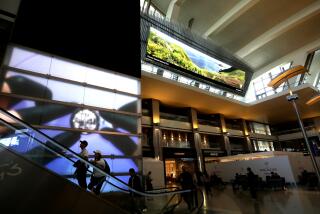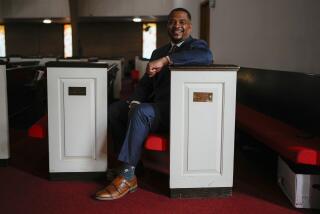Flights of Antsy Over Chicago Airport
- Share via
CHICAGO — As it crossed into Illinois, United Airlines Flight 38 from Los Angeles seemed to be offering an explanation for its own tardiness. Its path provided a tour of the battlefields in a political war that has made O’Hare International Airport a dreaded destination--and done much to scramble the nation’s air traffic system.
The Boeing 757 passed near the state capital of Springfield, long ruled by Republicans who want to build a new airport to ease congestion at O’Hare but who insist it be built outside of Democratic-controlled Chicago. It passed over the town of Peotone, which Republicans think would be a perfect home.
The plane then banked north, providing a view of Chicago City Hall, ruled by Mayor Richard M. Daley. His father, the late Mayor Richard J. Daley, developed O’Hare, once the gem of the nation’s airports. Thirty-three minutes late, the flight finally touched down at the airfield, now with the third-worst on-time record in the nation and perhaps the worst reputation with travelers.
(The two with worse on-time records, New York’s LaGuardia and Newark International in New Jersey, are much smaller facilities.)
After decades of partisan fighting, Congress now is considering an extraordinary move: seizing the issue from the locals and settling the matter at the federal level, on the grounds that airports affect interstate commerce.
On a perfect day for flying, O’Hare typically runs 3 1/2 hours behind schedule, affecting tens of thousands of the 200,000 passengers who travel through each day, according to a recent Federal Aviation Administration finding. When the weather gets bad, that can stretch to eight hours.
“I hate this place,” said one of the United passengers, a woman named Mary who had just missed her connection home to Madison, Wis. “I mean it, I hate it.”
Many factors have contributed to Chicago’s air travel problems, from unforeseen growth in the number of travelers to walkouts by airline employees.
More than anything, however, O’Hare (which is considerably larger than the area’s other major airport, Midway) has become a hub to dread thanks to decades of slash-and-burn politics.
As is tradition in Chicago politics, the story of the airport fight is filled with charges of cooked books, payoffs and volumes of well-heated air.
With very few exceptions, Republican leaders support a new facility at Peotone--and can point to half a dozen studies that show they’re right. At the same time, Republican Gov. George Ryan has veto power over expansion at any airport in his state, a power held by just eight other governors.
Most Democrats support building new runways at O’Hare and point to half a dozen studies of their own.
The airport fight might be dismissed as a local squabble except that O’Hare, once the world’s busiest airfield and now second to Atlanta’s Hartsfield, is a hub for the nation’s two largest airlines, United and American. And any glitch here can wreak havoc throughout the country, as hundreds of thousands of travelers learned last summer during a labor dispute at United.
Pressure to do something has grown in recent weeks in part because two senators have proposed taking the issue away from the fighting parties and settling the dispute in Washington, D.C. Much to the chagrin of Daley and Ryan, the senators forcing the issue aren’t even from Illinois. They’re from Iowa, and, along with their constituents, frequently find they have no choice but to fly through O’Hare.
“We’ve waited year after year to see something done, and nothing’s happened,” Sen. Tom Harkin (D-Iowa) said earlier this spring. “This is a national problem. . . . And if the local and state people don’t move on this rapidly, then we will.”
Harkin and fellow Iowa Sen. Charles E. Grassley, a Republican, argue for expanding O’Hare.
Politics Colors Expansion Needs
Last week, Rep. William O. Lipinski (D-Ill.) weighed in as well, introducing legislation that would speed expansion at O’Hare by stripping states of the power to block such construction. Numerous other members of Congress also have joined the call for action recently.
Sen. Peter Fitzgerald (R-Ill.) hopes to build a third airport so “we won’t have to eat the billions of dollars that rebuilding O’Hare would cost.”
Daley, when told recently that his own airport commissioner had for the first time conceded a new airfield eventually would be needed, scoffed: “When? In 2080?”
Many experts say the best plan indeed may be both plans: Add new runways at O’Hare and start building a third airport. But they’ve been saying that for years.
Despite mounting evidence to the contrary, Daley and city officials for years denied that a third airport--or even expansion at O’Hare--was needed. Only in recent weeks have they publicly supported new runways at O’Hare, the only one of 27 hub airports in the nation that neither has built nor planned new runways.
The reason, says attorney Joseph Karaganis, is simple: Any new airport would be outside city control, and expanding O’Hare would infuriate residents in the surrounding, Republican-leaning suburbs who already endure the noise of an average of 2,466 flights per day.
“Since 1980 at least, the city of Chicago has known that it needed either new runways or a new airport,” said Karaganis, who has spent years working for a third airport. “For 20 years they lied; they said they didn’t need either.”
Lip Service to New Airport Idea
Over the last few decades, the city has made the occasional nod toward expansion.
In 1990, with Republican George Bush in the White House and pressure growing for a third airport, Daley stunned many by announcing plans for a new facility at Lake Calumet, still within the city limits. The plan stalled but may have served its intended purpose.
Last year, the Chicago Tribune uncovered a document from a firm hired by the city to study the airport issue. By pitching Lake Calumet, the memo said, Chicago had “succeeded in preventing [the state] from making any meaningful progress toward developing an airport at a suburban location.”
Under former President Bush, the FAA provided $2 million to start planning a Peotone airport. When Bill Clinton took the White House, with considerable support from the Daley family, the issue of Peotone all but vanished at the FAA.
The mayor’s brother, Bill Daley, served as Commerce secretary under Clinton and before that as a lobbyist for United Airlines, which, along with American, hates the idea of a new airport.
The two carriers control 85% of the flights at O’Hare, and a new airport would open up the market to rivals.
At the same time, the state and most Republicans have pitched the idea of a Peotone airport despite evidence that there may be better options.
Peotone is more than 30 miles from the Chicago Loop--nearly twice as far as O’Hare. A rush-hour drive from O’Hare to the city already takes more than an hour. Gary, Ind., on the other hand, is about the same distance away as O’Hare, and already has a small-but-expandable airport. But it’s in Indiana.
Besides, in a typically shrewd move, Daley already has been there.
In 1995, the mayor secretly signed a compact with the Gary airport that would give Chicago considerable control over an expanded field there.
Nothing at the airport changed during the Clinton years. But with a Republican back in the White House, Daley and Chicago city officials once again are talking about expanding what is now known as Gary/Chicago.
“When you make a mistake on something like this, it’s a colossal mistake,” said Kenneth Janda, a political science professor at Northwestern University and an expert on state and city politics. “And politicians think incrementally when they don’t have the big solution.”
More to Read
Sign up for The Wild
We’ll help you find the best places to hike, bike and run, as well as the perfect silent spots for meditation and yoga.
You may occasionally receive promotional content from the Los Angeles Times.






